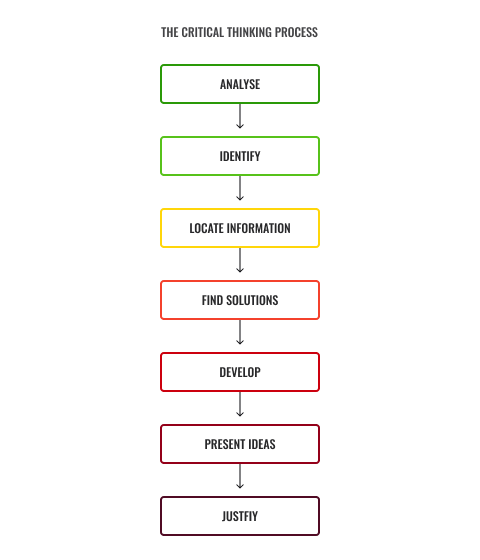The critical thinking process plays a significant role in any setting. It is applicable whenever you are required to solve problems, make decisions or create and share new concepts and ideas. As an employee, you may be required to follow a critical thinking process to improve or resolve problems with work practices. It helps you look beyond what is expected of you. Staff from all levels of an organisation may have well-developed higher-order critical thinking skills and be well-placed to problem-solve. Higher-order thinking is not exclusive to professional staff, supervisors, team leaders or managers.
This topic covers the seven steps for leading a critical thinking process. We discuss how to analyse existing and proposed work practices and identify their limitations (problems or issues) using critical thinking techniques. We also discuss how information sources (such as employee feedback and surveys) can be used to develop solutions. Next, we will consider how to use decision-making frameworks for prioritising tasks. Finally, we will learn how to develop and present a proposal to stakeholders for resolving a work issue.
Seven steps for leading a critical thinking process
This topic works through the following seven steps.
- Analyse a work practice
- Identify workplace and work practice limitations
- Locate information sources to help you decide on possible solutions
- Find solutions for work issues or workplace limitations
- Develop a proposal for solutions using a decision-making framework and organisational policies and procedures
- Present ideas for solutions
- Justify your decision

Each step of the process will be covered in detail and a workplace scenario will be provided to demonstrate the process. The seven step process can be applied to both current and proposed work practices and workplace limitations. In this module, the scenarios are based on a fictitious company called Ace Services.
Critical thinking techniques can be used to analyse existing and proposed work practices. You will learn about the features of work practices and how you can analyse these. You will also learn about the difference between existing and proposed work practices.
Work practices
Work practices generally refer to the unspoken and unofficial way certain tasks are done in the workplace. They refer to how the collective group does tasks, for example, how employees dress and when lunch breaks are taken. All workplaces have a work culture which is the mix of an organisation’s leadership, values, traditions, beliefs, behaviours, and attitudes. This can be summarised as ‘the way we do things around here.' This can be confusing for people when what is expected of team members is implied, rather than categorically stated. Let us look at two examples.
| Work practices | Implied expectations |
|---|---|
| You are currently working from home, and your organisation uses group chats in MS Teams to communicate during work hours. Sometimes, you set your Teams status message to 'Busy' or 'Do Not Disturb' because you do not want to be interrupted while working. | This practice seems to be common, but you know that you are expected to respond to messages regularly and promptly throughout the day, especially when they concern you and your work. While this policy is not official and is not written in your organisation's handbook, you are inclined to follow it, since this is what other staff appear to do. |
| You work in an open plan office and sense that staff prefer a quiet work environment. You would love to have a joke and a laugh with other staff, but feel that it would not be appreciated. | Even if your organisation's policies do not specifically state that music and loud laughter should be avoided, you see that the staff in the office are working quietly and therefore you do as well. |
Work practices and their features
The following table provides examples of work practices and their features.
| Work Practice | Example features of the work practice |
|---|---|
| How staff dress | Staff dress smart-casual. Often staff wear jeans with business shirts or blouses and flat casual shoes. |
| Lunch breaks | Time taken for lunch is flexible. Staff take breaks when it best fits around their daily priorities. |
| Using Microsoft Teams to communicate with colleagues | Each user updates their status to reflect their current state. For example, when focused on a priority task, they will set their status to 'do not disturb'. |
| Staff bringing dogs to work | Staff have the option of bringing pet dogs to work. |
Current and proposed work practices
Knowing your organisation’s current and proposed work practices will help you identify areas you need to focus on. Current work practices refer to those practices that are currently being implemented. For example, the organisation you work for has a practice of supplying homemade cakes and coffee to staff before work on Monday mornings. Monday morning 'cake and coffee' is a practice that has existed for some years and continues today. Proposed work practices, on the other hand, refer to those that are still in the process of being implemented. An example of this would be if your manager proposed a new work practice that requires you to take 15-minute breaks in the afternoon. This practice is new and has not been implemented yet.
Step 1: Analyse a work practice
The first step involves scrutinising the work practice or practices that currently exist in your workplace and working out why they don't produce the results they should. A question you might ask is: Why is the organisation receiving a high number of complaints?
In Step 1, you:
- list down the work practice
- get a 'feel' for the issue/problem
- document how the problem came to light, for example, via the complaints process
- list the pros and cons of the work practice
- decide who needs to be questioned and what you will ask them
- decide on what information you need. This could include locating relevant work procedures
- identify any trends and patterns in your data including through statistical tools.
Scenario
The work practice: Ace Services team meetings are held online using Microsoft Teams (group chat or video calls) because staff now work one or two days a week from home. Michelle is not convinced about the effectiveness of online meetings and applies her critical thinking to determine the effectiveness of online meetings. Michelle is aware that some team members are not participating in the group chats and she wonders if this is because they are not confident using Microsoft Teams. Michelle lists the pros and cons of holding meetings online. She also notes down the trends and patterns she observes (for example, the meetings are much shorter than when face-to-face). Michelle speaks with team members to ask their opinions. She also writes down a list of questions for stakeholders (for example, the IT staff and workplace trainers) as their feedback will broaden her understanding of the work practice.
After analysing the process, the information you have collected and documented will determine if there are limitations or weaknesses in the work practice or workplace. The second step involves identifying the limitations in the workplace or work practice that negatively affect you and your team’s work performance. Common limitations include:
- lack of policies, procedures or guidelines
- unclear or outdated instructions
- low morale amongst team members
- faulty computer hardware
- time restraints
- financial restraints
- poor communication between stakeholders.
Techniques to identify limitations in work practices

You will notice some of the techniques outlined below, are also referred to in Step 1. That is because we spend many hours, each day, communicating in one form or another. The techniques mentioned in Step 1, and outlined below, are used by critical thinkers.
- Active listening: active listening refers to paying careful attention to the speaker by putting aside whatever is distracting you. Active listening is a commitment and choice you make every time someone speaks with you.
- Asking questions: through the use of open and closed questions, you can achieve an accurate understanding of what is being discussed.
- Considering the perspectives of others: being mindful of those around you and respecting their opinions will help ensure effective communication.
- Identifying pros and cons: a valuable aspect of critical thinking is to compare situations and look at both the positives and negatives of the situation.
- Predicting outcomes: by making predictions, you will have a better idea of what to expect when you make your decision.
- Paraphrasing: repeating what you have understood in your own words. This ensures you understand what is being said.
- Observing non-verbal cues: body language and eye contact can be valuable indicators of an individual being engaged or not engaged in the current situation.
- Providing positive feedback: providing feedback helps motivate the listener, boosts their confidence and shows people you value them.
In this video, you will see active listening taking place during a conversation.
Scenario
Michelle has identified there are several limitations to holding online team meetings. She identifies the limitations after discussions with her team and other stakeholders. She also read journals about how effective digital and collaborative technology is, or isn't, for meetings. The limitations she identified include:
- not all team members have a suitable space at home for participating in online team meetings
- internet connections fail
- online meetings are less dynamic
- online meeting etiquette is not followed by all team members leading to frustration and anger
- some team members are reluctant to participate - they may be shy or unsure about using technology
- there has been no training for staff on how to effectively use Microsoft Teams
- the quality of equipment is not suitable for team meetings eg. sound is unclear
- there is no agenda for the meetings and therefore meetings are not as productive.

The third step is to obtain information. After you have identified the root cause of your workplace limitations, you can then begin finding solutions that will address your concerns. Finding effective solutions that will address your problems is not always an easy process. You first must locate information on your work practices before you can brainstorm solutions. Examples of information include:
- feedback from co-workers, customers, clients, volunteers and other stakeholders
- existing workplace policies and procedures, and incident and accident reports
- federal and state laws and acts such as the Work Health and Safety Act 2011
- surveys
- suggestion boxes
- complaints
- reports
- public notices.
When you obtain information by conversing with people or holding meetings, interviews and discussions, be mindful that your communication is appropriate. You need to be friendly, listen to what they have to say and be empathetic to avoid being judgmental. Locating information about your work practices will involve identifying the information required and the possible sources you might use. While researching information may seem like an easy task, not all available sources are reliable. Using reliable sources is part of being an accurate, critical thinker. There are two factors to consider when evaluating sources: reliability and relevance.
Questions to obtain reliable and relevant information
A reliable source has accurate content, written by a credible author, updated to current findings, and provides enough information to discuss the subject matter. The following questions can help you obtain reliable information:
- What kind of problem are you dealing with?
- What type of information is required?
- Where will you be obtaining this information?
- How will you be obtaining this information?
- Is the information you obtained based on facts and credible evidence?
A relevant source, on the other hand, must support the topic, contain recent and complete information and provide answers that address the root cause of your workplace limitation.
Information gathering can help create solutions
The information you have researched can help create new solutions to existing limitations or problems in your workplace. The following information can help you create solutions.
- Separating opinions from facts: obtaining information from credible sources can help you separate opinions from facts. It also helps you stay focused on the problem by making sure your ideas are consistent.
- Promoting creativity and critical thinking in the workplace: creating innovative solutions requires creativity and critical thinking. The information you have obtained can also encourage you to brainstorm new ways that may help you solve your problem. It may also help you gain a different understanding of your problem and anticipate the long-term effects of your proposed solutions.
- Providing different alternatives that may help you solve your problem: the information you have researched can provide you with different alternatives that may help you in creating a solution. It can help you analyse the factors that may improve your process. It can also help you identify the root cause of your problem so you can solve it faster.
Scenario
Michelle has gathered information from reliable sources (including team members, colleagues, and Ace Service’s IT department) about the effectiveness of running online meetings with staff who work from home. She has also read a research paper related to this issue. To ensure her information is reliable, Michelle answers the following questions.
- What kind of problem are we dealing with? A technical issue. There are complaints from staff that their internet at home drops out and their providers are unreliable. Therefore, they miss the meetings entirely or parts of the meeting and this is leading to frustration amongst the team.
- What type of information is required? Facts such as information from the staff asking them how often their internet drops out in a meeting and for how long each time. Michelle also asks her colleagues if their teams have the same problems and if so, how they resolved the issue. She speaks with her IT team to learn more about using Microsoft Teams.
- Where will I get this information? From team members, colleagues, Ace Service IT Department, the service provider and a research paper.
- How will I get this information? Through conversations, in meetings, by phone calls, emails and written documentation.
- Is the information I obtained based on facts and credible evidence? Yes, by targeting specific team members, IT experts, colleagues and reading peer-reviewed journals and other credible documents.
Tips to check the credibility of information source
You might like to use the following guide to help you determine if your sources are credible.
Sites ending in .gov refer to government sites. Sites ending in .edu refer to university web sites. Sites ending in .ac refer to academic institutions. This may refer to institutions like colleges, universities, and research institutes.
Using materials published within the last ten years should show that your information is up-to-date, relevant and reflecting the newest processes, theories, and discoveries.
Always ensure to use sources from authors who are researchers or scholars in your chosen field, have degrees (PhD, MA, MS) in your chosen field and are experienced in discussing their research with an audience.

We have discussed critical thinking concepts. However, it is crucial to know how to develop solutions using the concepts discussed. You can use critical thinking concepts and information from reliable and relevant sources to develop solutions to work practices and workplace limitations. When using critical thinking concepts in developing solutions, ensure that you check for the following:
When developing solutions for workplace limitations, it is important to determine whether statements are clearly explained. Moreover, it is vital to state your intentions clearly to avoid misunderstandings and confusion.
Ensure that the data you are using is backed up by facts and evidence. Always make sure that you are using accurate information when developing your solution. Avoid typographical mistakes and dated information. Remember to check for errors and false or fake information as well.
Remember to check if your ideas are cohesive. Logicalness is important in developing solutions for workplace limitations. This is because it helps you analyse and observe situations and draw conclusions based on the information you obtained. When developing solutions, always ensure that your ideas make sense, are related to each other and follow a logical sequence of events (that is, arranged according to importance or time).
Refer to the following steps to guide you in developing solutions using critical thinking concepts.
Identify your workplace limitation
The first and most essential step to developing a solution to your workplace practices is identifying its limitations. This step is important because it serves as a starting point for your solution. You cannot develop a solution without knowing what you are dealing with or what you want to improve. You must know the details surrounding your limitation and identify factors that make your work practice a limitation. Therefore, make sure to identify the limitations before you develop your solution.
Analyse your workplace limitation
This step is important because it involves knowing all the details about what you are trying to fix and fully understanding why your work practice or workplace limitation needs to be addressed. Ensure to analyse your current workplace practice by:
- obtaining as much information as possible about the work practice
- getting a 'feel' for the issue/problem
- documenting how the problem came to light, for example, via the complaints process
- listing the pros and cons of the work practice
- deciding who needs to be questioned and what you will ask them
- deciding on what information you need. This could include locating relevant work procedures
- identifying any trends and patterns in your data including through statistical tools.
Think of possible solutions
There can be countless solutions to just one problem. Always remember to take time to think of all possible solutions and choose solutions that fit together. Think logically of solutions that may address your problem. For example, list down alternatives, enumerate each alternative’s pros and cons, and brainstorm ideas that can improve your alternatives. You can also ask yourself the following questions for guidance.
-
Is it feasible? Checking your solution’s feasibility is the first thing to consider when developing a solution. It helps you determine whether you can or cannot implement your devised alternatives. It is easy to overlook this step when you are busy formulating options, but always ensure you remember to check if your solution can be done so you will not encounter problems later on.
-
Will it actually solve the problem, or will it create other problems? Some solutions only create even more problems. Determine whether your solution efficiently solves your problem. Your solution should be clear and concise, structured, address your goals, break barriers and be effective.
-
Who will be affected by these solutions? Creating an effective solution involves considering the perspectives of the members of your organisation. Always consider who will be affected by your solution so it can benefit as many stakeholders as possible.
Decide which solution best addresses your workplace limitation
After you have made a list of all possible solutions, narrow your choices down to the best possibilities. You can continue doing so until you have found the solution that will best address your workplace limitation. Always take time to analyse your options before choosing the best of the bunch.
Scenario
After collecting information, Michelle considers if any of the solutions could cause more problems and she culls these. Her final solution is to continue with online meetings as the positives outweigh the negatives. Staff are keen for meetings to be shared between online and traditional face-to-face meetings. However, they would like training in online meeting etiquette, as well as general computer skills training. Michelle has offered to develop guidelines for this work practice.

After you identify your problem and develop your solutions, you can now develop a proposal. Proposals are written to inform stakeholders about your current work practice, or workplace situation, so that your solution can be considered and implemented. When writing proposals, ensure that it conforms to your organisation’s policies and procedures and any legal requirements.
Components of a proposal
Proposals help outline an organisation’s plans for development. It also helps provide information on why an organisation is implementing its plans and what results are to be expected from these plans. Before writing a proposal, check with your organisation for specific requirements when creating a proposal. Requirements may include workplace policies and procedures and legal requirements such as following the WHS Legislation applicable to each state or territory.
Proposals generally have specific components. These are briefly described in the following table.
| Component | Description |
|---|---|
| Summary | This contains a two or three-sentence synopsis of your proposal. It helps your readers understand what your proposal is about. |
| Organisational information | This part contains a two to three-paragraph summary of your organisation’s history. Here, you may expect to find your organisation’s mission and its achievements. |
| Problem description | This part explains the issue/s your proposal aims to address. It tells the reader why these issues are important and persuades them to support your proposal. |
| Work plan |
The work plan has four sections that must be included:
|
| Impact of activities | This part of your proposal presents information on the changes your planned activities can have on your workplace or environment. It will also describe the changes your planned activities may bring. |
| Evaluation | This part will help readers know when your desired impacts have been achieved. Be sure to include information on how your planned activities were executed. Keeping a record of what you have achieved will help you evaluate your progress. |
Complying with workplace policies and procedures and legislative requirements
When it comes to developing proposals, ensure that your proposal is consistent with your workplace policies and procedures and the legislative requirements in your area.
For example, at Ace Service it is important that employees refer to the Decision Making Policy and Procedure before developing a proposal. This policy describes how to use the Eisenhower Matrix for prioritising tasks and the SPADE Model for decision-making. Employees should also refer to the organisation's style guide which provides guidance on how reports and proposals are written. This is important because it ensures that proposals and reports have a consistent 'look and feel' and present a consistent brand of the organisation. If disagreements or conflicts occur over the development of a proposal, staff would need to refer to the Conflict Resolution Policy and Procedure. These policies refer to the following important legislation:
When referring to this Act, always remember that the Work Health and Safety Act has different versions per state or territory. Therefore, it is important to check the legislation that is applicable to the state or territory you are currently in. The Work Health and Safety Act of 2011 was made to provide for work health and safety of employees, volunteers, out workers, trainees, and contractors. It aims to protect workers from anything that could compromise their safety, health, and welfare.
The Workplace Privacy Act of 2011 concerns monitoring work practices using tracking devices and computer or video surveillance. Here, employers may conduct surveillances in the workplace to monitor work progress or investigate alleged misconduct. Using surveillance equipment is a work practice that is common for most organisations. If employees work from home, employers still monitor their work progress through applications like Harvest and Hubstaff. More traditional means for monitoring employees include installing CCTV cameras and using logbooks.
There are also regulations that are relevant to workplace practices. Regulations can be federal, or state or territory based. An example of this is the Queensland Worker’s Compensation and Rehabilitation Regulation 2014
The Eisenhower matrix
The Eisenhower or Important - Urgent Matrix can help you determine which activities are important and which should be given less importance. The matrix was developed by Dwight D. Eisenhower, the 34th President of the United States. His busy schedule led him to invent the Eisenhower principle, which is the basis for the Eisenhower Matrix. Before you develop your proposal, there are two major considerations involved in determining your priorities, these are importance and urgency.
- Importance: matters that are vital in enabling you to achieve the goals and objectives you have set.
- Urgency: matters that need immediate attention and action.
DO FIRST quadrant: these tasks are important and urgent. They require your immediate attention and should not be skipped. For example, submitting projects to a deadline and responding to urgent emails.
SCHEDULE quadrant: these tasks are important but less urgent and may include scheduling meetings and replenishing supplies.
DELEGATE quadrant: these tasks are urgent but less important. For example you may request a team member to attend a meeting instead of you or assign tasks to your teammates who also have knowledge of what you want to accomplish.
DON'T DO quadrant: in this quadrant you would place tasks that are not important and not urgent. Some of these tasks may be considered your 'distractions'. Examples that fall into this quadrant might include spending time on formatting an email that is not necessary, or procrastinating by surfing the internet for information when you have sufficient to complete the task at hand.
The following video on the Eisenhower Matrix provides examples of tasks you might assign to each quadrant. Please note, the quadrant descriptors are worded differently to the diagram above, however, the intent is the same.
The SPADE decision-making framework
The SPADE decision-making framework was created by Gokul Rajaram in 2016. It was designed to help organisations make hard decisions that have real consequences for the company’s well-being. SPADE is an acronym that stands for Setting, People, Alternatives, Decide, and Explain.
This decision-making model involves presenting solutions that are based on the urgency and importance of your tasks. Use the following guide to learn more about the SPADE Framework:
- Setting: The setting establishes the tone for your decision. It informs your stakeholders of your intentions about solving your problem. Your setting has three parts: What, When and Why.
- People: People are the most crucial factor behind a decision. This part of the decision-making framework includes those who give input in the decision-making process, those who approve the decision, and those who are responsible for making the call. This section has three primary roles: Decision-maker, Approver and Consultant.
- Alternatives: This part refers to how your alternatives are presented. Alternatives refer to the solutions you considered in addressing your workplace limitation. You can clearly present and explain your alternatives by creating a proposal. Doing so helps minimise mistakes and misunderstandings in decision-making.
- Decide: After presenting your alternatives in a proposal, it is now time to present your proposal to important stakeholders. It is crucial to include important stakeholders in the decision-making process. Present your findings and ask for their feedback before making your decision.
- Explain: This step discusses your work plan and the impact your planned activities may have. Here, you may explain your alternatives and explain the expected impact of each one. You may also explain why each alternative is important and why a solution is needed to address your problem.
Like the Eisenhower Matrix, the SPADE decision-making framework can also be used to develop proposals that present your selected solution to your workplace limitation. For example, it informs stakeholders of the alternatives you came up with while developing your solution. It also provides you with a means to obtain feedback from your stakeholders about your selected solution.

Scenario
Michelle writes her proposal and asks a colleague to review it to ensure it reads well, is accurate, thorough and convincing. She believes she has covered all components of a proposal and is especially careful to address any work, health and safety concerns that could arise from her proposed solution. However, the reviewer questioned the order in which Michelle prioritised tasks in the work plan. She suggests Michelle revisits her proposal and also read the Ace Service Decision Making Policy and Procedure which describes the Eisenhower matrix to assist her prioritise the tasks.
Stakeholders are an important part of the decision-making process. They refer to any group, institution, or individual who has a role or interest in your organisation’s work practices and in developing solutions to address workplace limitations. Click on each of the following headings to learn more about each of these stakeholders.
Presenting your proposal
Writing the proposal is an important step, however, presenting it either physically or virtually (for example in a Skype or MS Teams meeting) is equally important. This is an additional opportunity to present and 'sell' your proposal persuasively. It also allows you to answer any questions, and clarify misunderstandings. Feedback may also indicate where you can strengthen your arguments or rationale in the proposal. There are three key components of an effective business proposal presentation:
- Content: This is what you will be sharing with the audience so that they can make an informed decision on the merit of the proposal.
- Visual design: This could include any visual materials such as a PowerPoint presentation to support the content of your presentation.
- Delivery: This refers to how you deliver the business proposal presentation.
Watch examples of two presentations, one much better than the other. As the coach notes, the written proposal was very good but the presentation lacked confidence. See how making just a couple of small changes can make a huge improvement to a presentation, making it confident, clear and impactful.
Scenario
Michelle presented her proposal to the management team because she needs their support to fund and implement training. Afterwards, she reflects on her presentation. She feels she lost valuable time in 'selling' her proposal through having to explain the contents of the proposal and asks Robert, her manager, for feedback. Robert suggests that next time, she circulate the proposal before the presentation to allow people time to read and understand the proposal. This will avoid some of the questions. He also suggests that Michelle could inject stories or testimonials into the presentation to bring the proposal to life, and explain how it directly benefits staff at Ace Service.

Decision-making will always involve justifying your decisions, especially when these decisions impact the lives of other people. Justification can be defined as:
Something that proves, explains or supports a position or argument.
When justifying your decision-making process to stakeholders, you need to communicate clearly, courteously and not make demands. Your purpose is to convince stakeholders to agree to your decision. In the Problem Description section of your proposal, you explain the issue you wish to address and why it is important. This is where you convince stakeholders to support your decision so it is important to present a well-written and powerful proposal. You don't need to go into the specifics of your argument in the Problem Description, however, you do need to make a strong and clear persuasive statement or request.
Tips for justifying your decision-making process
The following table has suggestions to help you justify your decisions.
| Tip | Description |
|---|---|
| Reassess your decision | Reassess your decision before meeting stakeholders. Reviewing your decision before you present it can help you be more prepared for your meeting. It can help you spot mistakes in your process and can also help you identify the solutions that yield good results. |
| Explain your decision |
Explaining your decision to major stakeholders can help them understand where you are coming from. This will help them grasp your solution and see things from your perspective. In this step, you identify your decision, explain the information you gathered, explain and weigh the pros, cons, risks, and consequences of your solutions, and explain your final decision. This is an important action because stakeholders can offer their insights on the decision-making process and help you improve your final decision. It is important to seek stakeholder input as they are directly or indirectly affected or influenced by your final decision. In the same way, they can directly or indirectly influence your decision. For example, supporting your decision, or withholding their support. |
| Explain the process |
When presenting your decision to major stakeholders, ensure to clearly explain your decision-making process and how you arrived at your final decision. The following guide will help you present your decision:
|
| Resolve lingering problems | No solution is perfect. Sometimes, problems arise even after you implement your solution. Resolving lingering problems can help you justify your decision-making process and can also help you revise your previous solutions. |
Scenario
At the last Ace Service management meeting, Michelle presented her proposal. Before the meeting, she practised her presentation and wrote answers to questions she thought might be asked of her, for example, the estimated cost to train her team in the use of digital technologies for online meetings. She carefully explained the possible solutions and argued convincingly for her proposed solution. At all times, Michelle remained calm and polite and used active listening. Michelle is quietly confident that her proposal will be accepted.
The final activity for this topic is a set of questions that will help you prepare for your formal assessment.
In summary, the critical thinking process is applicable in various settings and plays a vital role in problem-solving, decision-making, and generating new ideas. This topic focused on the seven-step approach to leading a critical thinking process in the workplace. It emphasized the importance of analyzing both current and proposed work practices to identify limitations and issues through the application of critical thinking techniques.
Key points
- When it comes to developing solutions that address a work issue or workplace limitation, aim for everyone to be involved in the decision-making process.
- Stakeholders need to be informed of proposed plans before they are implemented.
- Before you can begin finding solutions to a problem, you must collect sufficient information about the limitations of both the work practice and workplace.
- Gathering information is part of critical thinking.
- The 7 steps for leading a critical thinking process can be applied for current work practices and future work processes.
- Before presenting a proposal to stakeholders, it is wise to reassess your decision.
